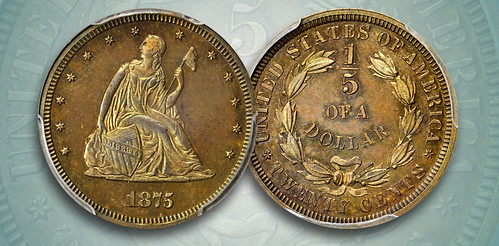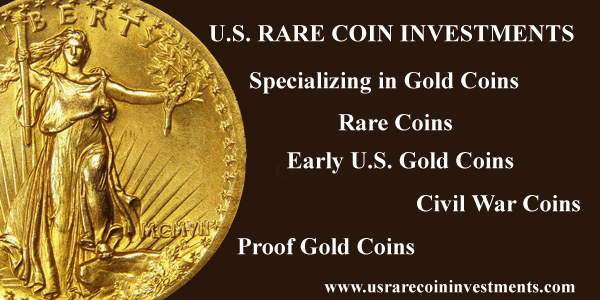
PREV ARTICLE
NEXT ARTICLE
FULL ISSUE
PREV FULL ISSUE
1875 ONE FIFTH OF A DOLLAR PATTERN
Cataloger James McCartney published an article in his November 9, 2016 Stack's Bowers blog about an unusual twenty cent pattern in the firm's November 2016 Collectors Choice Online Auction
-Editor

This experimental twenty-cent issue represents a significant milestone in the overall timeline of the denomination as it pertains to the US Mint. The double dime was first proposed as a concept by Thomas Jefferson as an equivalent to one fifth of a Spanish milled dollar, which was a prevalent increment of commerce in 18th century America. In a report to Congress on May 13, 1785, a grand committee of representatives from each of the thirteen colonies rejected Jefferson’s suggestion of a twenty-cent denomination in favor of the quarter dollar, choosing instead to emulate the more common Spanish double reale and English shilling which circulated at a value of twenty five cents. Proposals for a twenty-cent piece would be reintroduced to congress several times over the next century, failing to gain approval in both 1806 and 1850. It wasn’t until the after Mint Act of February 1873 upset the equilibrium of the nation’s coinage that suggestions of the denomination once again reappeared. This act eliminated the production of silver three-cent pieces, half dimes, and silver dollars, spawning both practical and political concerns that Senator John Percival Jones of Nevada worked aggressively to mediate. Of the more practical concerns, Jones argued, was the shortage of minor coins used to make change throughout the West. The most propagated scenario involved a consumer wishing to purchase an item valued at ten cents, but only having a quarter to pay with. The merchant, also tragically lacking small coins, would only be able to compensate the patron with ten cents in change, shorting them five cents. These exploitive transactions were epidemic throughout the Western US, as per Senator Jones, and a twenty-cent coin was necessary to remedy the situation, he argued. Less lauded though perhaps more encouraging was the threat to the silver mining industry that the reduction in coin production represented. The U.S. Mint was, at the time, the largest purchaser of silver in the world, and domestic mine owners were very concerned over reduced demand and lower prices. However, despite the seemingly persuasive nature of these concerns, Senator Jones persistently campaigned the “short-change crisis” as his primary argument for the twenty-cent piece, as lobbying too overtly for the mine owners might reveal the fact that he himself was a silver mine owner with a personal interest in the success of the proposed coin. While the legitimacy of the Senator’s claims has never been fully validated, his arguments were convincing enough and the twenty-cent piece was approved as part of the Act of March 3, 1875, nearly a century after Jefferson first suggested the denomination. Even prior to this official sanctioning, the Mint had begun trialing different designs for the pending double dime in 1874. Mint Director Henry R. Linderman wrote to Superintendent James Pollock on April 20 of said year with his own suggestions for a pattern to be executed, and examples were on hand by the end of the summer. Over the course of the following year, a total of six distinct design combinations would be evaluated, chiefly with the goal of finding ways to differentiate the new coin from the inconveniently similar quarter. A few designs chose to place the denomination 20 CENTS in large characters at the central reverse in order to avoid confusion. In an ever bolder suggestion, one reverse featured the denomination represented by a fraction, reading 1/5 OF A DOLLAR, filling up the upper and central fields. When paired with an obverse similar to the adopted design and struck in copper, this proposed pairing is classified under the Judd-1408 attribution and less than a dozen are thought to remain today.
I've always loved the U.S. pattern series, even though I've only ever collected a couple myself. These are the tangible evidence behind the history of our coin designs. Many are quite beautiful, some are downright ugly, but all are interesting. This one's no beauty, and much more interesting than most. Although fractions have been used for denominations (think 1/100 and 1/200 on our early cents and half cents), I don't recall any other coin or pattern spelled out like this: " 1/5 of a dollar". It's an odd duck and I'm glad the design never got the green light. Great pattern, though.
-Editor
To read the complete article, see:

Wayne Homren, Editor The Numismatic Bibliomania Society is a non-profit organization promoting numismatic literature. See our web site at coinbooks.org. To submit items for publication in The E-Sylum, write to the Editor at this address: whomren@gmail.com To subscribe go to: https://my.binhost.com/lists/listinfo/esylum All Rights Reserved. NBS Home Page Contact the NBS webmaster 
|